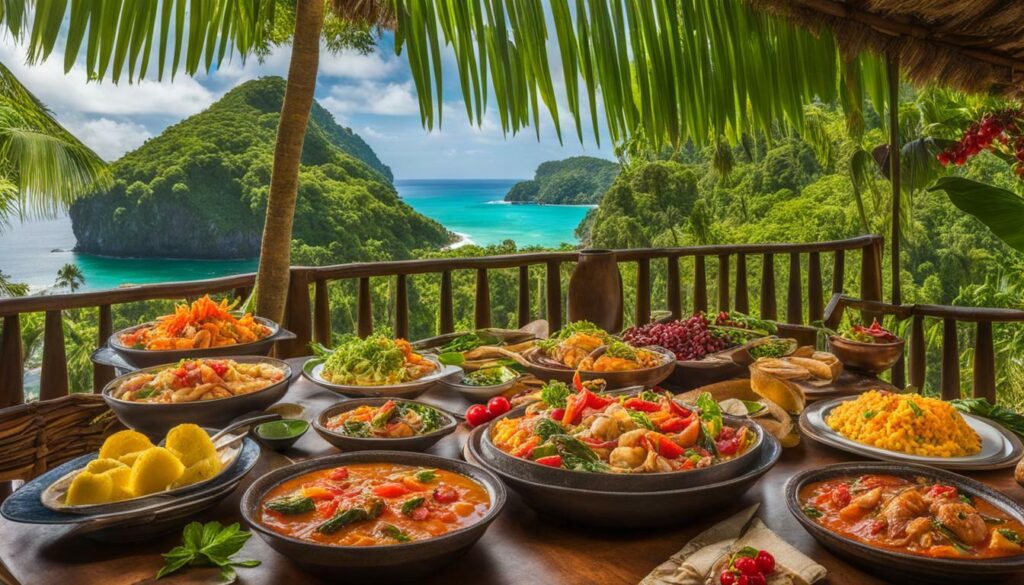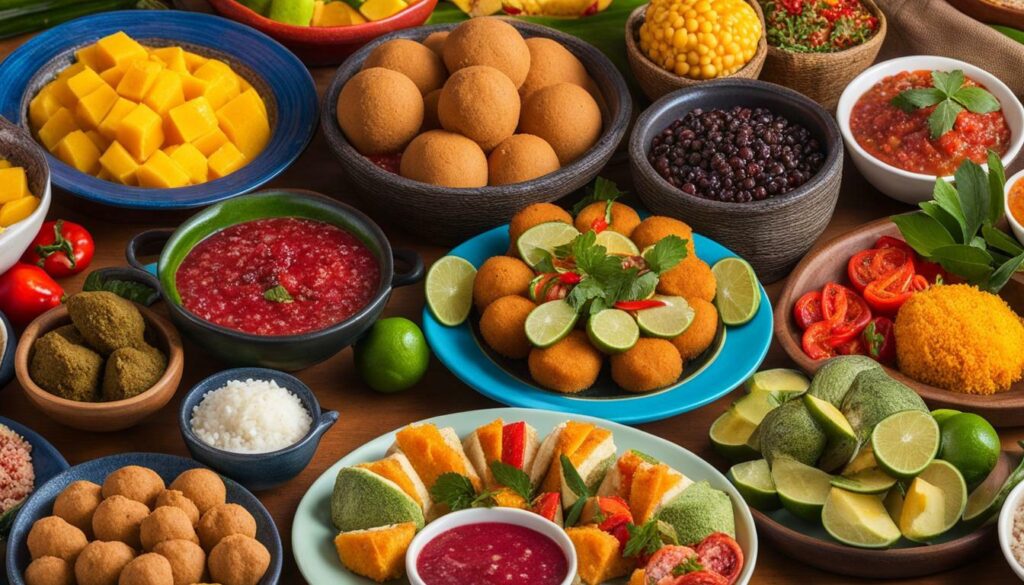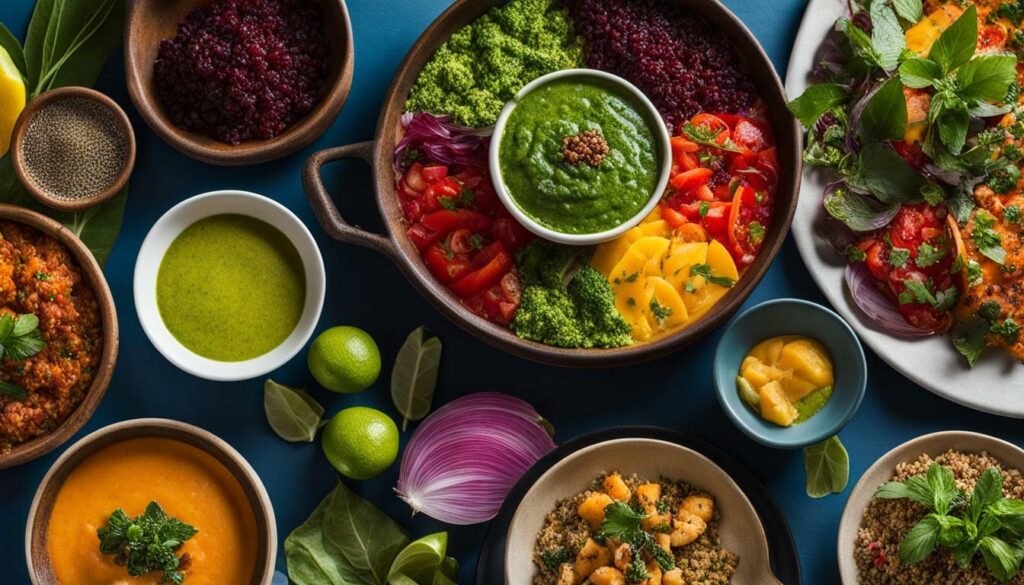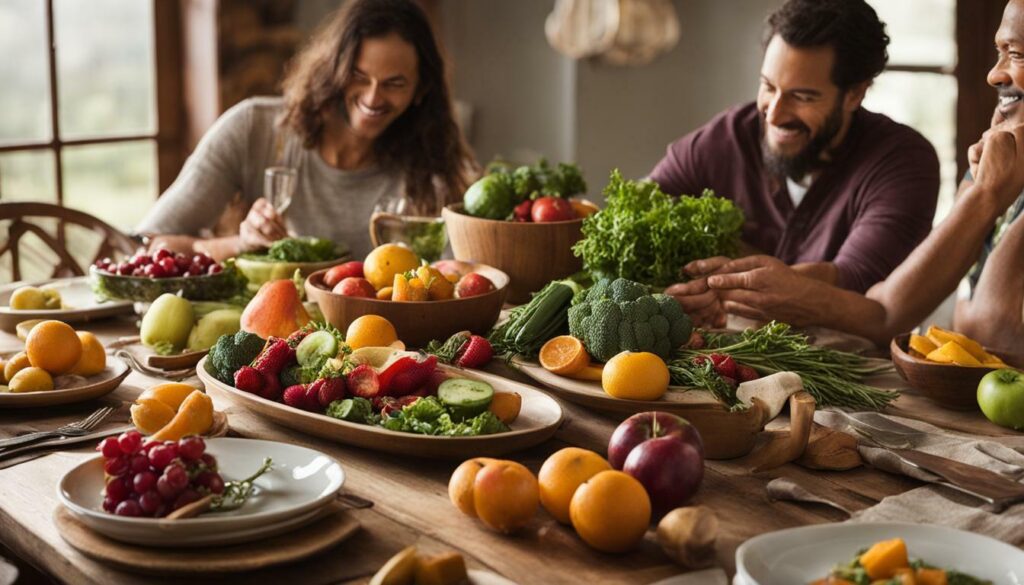Brazil’s culinary history is a tapestry of diverse flavours and influences, reflecting the country’s cultural diversity. From the indigenous tribes who first inhabited the land to the Portuguese colonizers and the African slaves brought during the colonial era, Brazil’s food traditions have been shaped by a fusion of cultures and ingredients.
Over time, these culinary traditions have evolved, blending traditional ingredients and cooking techniques with modern influences. Today, Brazil boasts a rich array of traditional foods that are celebrated both at home and abroad.
Key Takeaways
- Brazil’s culinary history is influenced by diverse cultures and ingredients.
- The country’s traditional foods reflect a fusion of indigenous, Portuguese, and African flavours.
- Modern influences have led to the evolution of Brazilian cuisine.
- The Brazilian government promotes a food guide that emphasizes natural, minimally processed foods.
- Family meals and local ingredients are key components of Brazilian cooking.
Traditional Brazilian Foods and Cuisine
Traditional Brazilian foods form the heart and soul of the country’s culinary identity, offering a tantalizing blend of indigenous, African, and European influences. From hearty stews to flavorful street snacks, Brazilian cuisine showcases a diverse array of dishes that have become beloved not only in Brazil but also around the world. These traditional foods reflect the cultural heritage of the country and provide a glimpse into its rich history.
One iconic dish that epitomizes Brazilian cuisine is feijoada, often hailed as the national food of Brazil. This hearty black bean stew is typically made with various cuts of pork, including sausages, bacon, and ribs, slow-cooked with onions, garlic, and spices. Served with rice, farofa (toasted cassava flour), and collard greens, feijoada is a perfect representation of the country’s love for bold flavours and hearty meals.
Another classic Brazilian dish is acarajé. Originating from the northeastern state of Bahia, acarajé is a deep-fried ball of black-eyed pea dough stuffed with a flavorful mixture of shrimp, vatapá (a spicy shrimp and peanut sauce), and caruru (a condiment made from okra, onions, and spices). This popular street food is a delicious example of the African influence on Brazilian cuisine.
| Dish | Description |
|---|---|
| Feijoada | A hearty black bean stew with various cuts of pork, served with rice, farofa, and collard greens. |
| Acarajé | A deep-fried ball of black-eyed pea dough stuffed with shrimp, vatapá, and caruru. |
Brazilian cuisine also boasts a wide range of tropical fruits and fresh seafood. The country’s vast coastline provides an abundance of fish and shellfish, which are often prepared using simple yet flavorful techniques. Moqueca, a seafood stew made with coconut milk, tomatoes, onions, and spices, is a popular dish from the coastal regions of Brazil. The combination of fresh seafood and aromatic ingredients creates a dish that is both vibrant and delicious.
As you explore the traditional foods of Brazil, you’ll discover a captivating blend of flavours, colours, and textures that showcase the country’s unique culinary heritage. Whether you’re indulging in a plate of feijoada or savouring the tropical sweetness of fresh mango, each bite offers a glimpse into the rich tapestry of Brazilian cuisine.

Festive and Popular Foods in Brazil
From feijoada, the beloved national dish, to brigadeiros, the delightful chocolate truffles, Brazil boasts a wide array of festive and popular foods that capture the essence of the country’s culinary traditions. These dishes not only satisfy the taste buds but also reflect the vibrant and diverse cultural heritage of Brazil. Whether it’s a family gathering, a religious celebration, or a carnival feast, Brazilian cuisine takes centre stage, offering a unique gastronomic experience.
One of the most renowned festive foods in Brazil is feijoada. This hearty stew consists of black beans, various cuts of pork, and smoked sausages, slow-cooked to perfection. Served with rice, collard greens, farofa (toasted cassava flour), and orange slices, feijoada is a quintessential dish that brings people together and symbolizes unity and tradition.
Another popular treat in Brazil is brigadeiros. These bite-sized chocolate truffles, made from condensed milk, cocoa powder, butter, and chocolate sprinkles, are a favourite at birthday parties and other festive gatherings. Brigadeiros are not only delicious but also represent the joyful and sweet side of Brazilian cuisine.
| Festive Foods in Brazil | Popular Foods of Brazil | Famous Foods in Brazil |
|---|---|---|
| Feijoada | Açaí bowl | Pão de queijo |
| Moqueca | Coxinha | Caipirinha |
| Quindim | Empada | Churrasco |
These are just a few examples of the many festive and popular foods that Brazil has to offer. The country’s rich culinary heritage continues to evolve with new flavors and dishes, while still paying homage to its traditional roots. Whether indulging in a steaming plate of feijoada or savouring a brigadeiro, experiencing Brazilian cuisine is a celebration of culture, community, and culinary delight.

Bela Gil and the Healthy Twist on Traditional Brazilian Dishes
Bela Gil’s innovative approach to Brazilian cuisine has garnered her widespread acclaim, as she reimagines traditional dishes with a focus on health and well-being. As the host of the popular TV show Bela Cozinha, she has inspired countless Brazilians to embrace a healthier lifestyle by making simple yet impactful changes to their diets. Bela’s philosophy revolves around using fresh, locally sourced ingredients and cooking from scratch to create nourishing meals that are both delicious and nutritious.
Through her show, Bela introduces viewers to a wide range of Brazilian food dishes and recipes, showcasing the diversity of flavours and ingredients that make up the country’s culinary heritage. She takes traditional recipes and adds her own unique twist, often incorporating superfoods, whole grains, and plant-based alternatives to create healthier versions of beloved classics.
Bela’s emphasis on using natural, minimally processed ingredients aligns with the Brazilian government’s food guide, which encourages the consumption of foods that are native to Brazil. Her recipes often feature locally grown fruits, vegetables, and herbs, harnessing the flavours and benefits of these ingredients to create vibrant and nutritious meals.
“Cooking is a powerful way to connect with our culture and take control of our health. By making small changes in our everyday food choices, we can make a big difference in our lives,” says Bela Gil.

Bela Gil’s Top Three Healthy Brazilian Recipes:
- Tapioca Pancakes with Banana and Chia Seeds
- Black Bean Stew with Quinoa and Kale
- Açaí Bowl with Fresh Fruits and Granola
These recipes are just a glimpse into Bela’s repertoire of healthy Brazilian dishes. By embracing Bela’s approach and incorporating her recipes into their diets, Brazilians can enjoy the rich flavours of their culinary heritage while prioritizing their health and well-being.
In the next section, we will explore the Brazilian government’s food guide and how it promotes sustainable and culturally appropriate food choices.
The Brazilian Government’s Food Guide
The Brazilian government’s food guide has revolutionized the way Brazilians view their diets, encouraging them to embrace culturally appropriate and sustainable food choices. This comprehensive guide emphasizes the consumption of natural, minimally processed foods that are native to Brazil, promoting healthier eating habits and a closer connection to the country’s culinary heritage.
One of the key principles of the Brazilian food guide is the importance of family meals. It encourages families to come together and enjoy slow-cooked meals made with locally sourced ingredients. This not only fosters a sense of unity and connection, but it also supports local farmers and promotes the use of fresh, seasonal produce.
The guide also highlights the negative effects of ultra-processed foods and encourages Brazilians to reduce their consumption of snacks and fast food. It suggests opting for homemade meals whenever possible, as they are typically healthier and more nutritious. By discouraging the reliance on ultra-processed foods, the government aims to improve public health and reduce the prevalence of diet-related diseases.

The Brazilian government’s food guide has been praised for its focus on sustainable food choices. It acknowledges the importance of preserving culinary traditions and sustainability practices while promoting healthy eating habits. By embracing these principles, Brazilians have the opportunity to not only improve their overall well-being but also contribute to a more sustainable food system.
| Foods to Emphasize | Foods to Limit |
|---|---|
| Natural, minimally processed foods | Ultra-processed foods |
| Locally sourced ingredients | Fast food |
| Culturally appropriate dishes | Snacks and sugary drinks |
By following the Brazilian government’s food guide and embracing a balanced approach to diet, Brazilians can nourish both their bodies and their cultural heritage. This guide serves as a valuable resource, empowering individuals to make informed food choices that benefit not only themselves but also the environment and future generations.
Emphasizing Family Meals and Local Ingredients
In Brazil, family meals are cherished traditions that bring loved ones together, often featuring slow-cooked dishes prepared with locally sourced ingredients. These meals create an opportunity for families to connect, share stories, and pass down culinary traditions from one generation to the next. The use of local ingredients not only adds authenticity to the dishes but also supports local farmers and promotes sustainable food practices.

One of the key aspects of family meals in Brazil is the emphasis on slow cooking. Traditional recipes often require long hours of simmering and stewing, allowing the flavours to meld together and creating a rich and satisfying dining experience. This cooking method not only leads to delicious meals but also encourages mindfulness and appreciation for the process of food preparation.
Benefits of Family Meals and Local Ingredients
Family meals have been shown to have numerous benefits, including improved communication, stronger family bonds, and healthier eating habits. By prioritizing shared mealtimes, families can create a sense of unity and belonging, while also instilling important values around food and nutrition. Research has shown that children who regularly eat meals with their families are more likely to consume a wider variety of foods and develop a positive relationship with food.
In addition to the social and emotional benefits, using locally sourced ingredients supports the local economy and reduces the carbon footprint associated with transportation and storage. By choosing ingredients that are in season and grown nearby, families can enjoy fresher produce, support local farmers, and contribute to a more sustainable food system.
In conclusion, family meals and the use of local ingredients are integral parts of Brazilian culture and cuisine. By embracing these traditions, not only can families create lasting memories and foster strong relationships but also promote healthier eating habits and sustainable food practices. So gather your loved ones, prepare a slow-cooked feast with locally sourced ingredients, and savour the flavours of Brazil’s rich culinary heritage.
Discouraging Ultra-Processed Foods
Recognizing the negative impact of ultra-processed foods, the Brazilian government aims to reduce their consumption and promote healthier alternatives. Ultra-processed foods, which are high in added sugars, unhealthy fats, and artificial additives, have been linked to various health issues including obesity and chronic diseases. In an effort to improve the overall health of the population, the government has implemented strategies to discourage the consumption of these harmful food products.
The Brazilian government’s food guide, released in 2014, plays a crucial role in promoting a healthier diet. The guide emphasizes the importance of consuming natural, minimally processed foods that are native to Brazil. By prioritizing locally sourced ingredients and traditional cooking methods, the guide encourages Brazilians to embrace a more sustainable and culturally appropriate approach to eating.
“Food is a fundamental part of our culture, and it has a direct impact on our health,” says Bela Gil, a renowned chef and host of the popular TV show Bela Cozinha. Gil’s show exemplifies the government’s mission to put a healthy spin on traditional Brazilian dishes. With her focus on nutritious ingredients and cooking techniques, she inspires viewers to make positive changes to their diets.

Table: Comparing Ultra-Processed Foods and Healthy Alternatives
| Ultra-Processed Foods | Healthy Alternatives |
|---|---|
| Sugary breakfast cereals | Whole-grain oatmeal with fresh fruits |
| Fast food burgers and fries | Home-cooked lean meat with oven-baked sweet potato fries |
| Soda and sugary drinks | Natural fruit juices or infused water |
| Packaged snacks and cookies | Homemade trail mix or fresh fruit with yoghurt dip |
The government’s efforts to discourage ultra-processed foods and promote healthier choices have been met with positive reception. However, the success of the initiatives relies on the willingness of Brazilians to embrace a return to simpler, rustic meals and reduce their consumption of snacks and fast food. By prioritizing the consumption of locally sourced ingredients and preparing meals at home, individuals can take control of their health and contribute to the preservation of Brazil’s culinary traditions.
Return to Simpler, Rustic Meals
The success of the Brazilian government’s food guide hinges on whether Brazilians are willing to embrace the return to simpler, rustic meals and reduce their reliance on snacks and fast food. Bela Gil, host of the popular TV show Bela Cozinha, has advocated for a healthier approach to traditional Brazilian dishes, inspiring many to explore alternative cooking methods and ingredients.
One key aspect of this return to simplicity is the emphasis on family meals. The Brazilian government’s food guide encourages families to gather and enjoy slow-cooked, home-cooked meals made with locally sourced ingredients. By promoting the use of fresh produce, traditional grains, and lean proteins, the guide aims to not only improve the nation’s health but also support local farmers and producers.
In addition to advocating for healthier eating habits, the guide also discourages the consumption of ultra-processed foods. Brazilians are being encouraged to reduce their intake of snacks and fast food, which are often high in added sugars, unhealthy fats, and preservatives. Instead, the focus is on returning to the roots of Brazilian cuisine, which is characterized by its simplicity and reliance on natural ingredients.

Benefits of Simpler, Rustic Meals
Choosing simpler, rustic meals offers numerous benefits for both individuals and the environment. By opting for locally sourced ingredients, Brazilians can support local economies and reduce their carbon footprint by minimizing the transportation of food. Additionally, consuming minimally processed foods can contribute to improved overall health and well-being.
Table: Traditional Brazilian Dishes
| Dish | Description |
|---|---|
| Feijoada | A hearty black bean stew with various cuts of pork and beef. |
| Moqueca | A flavorful fish stew made with coconut milk, tomatoes, peppers, and spices. |
| Acarajé | A deep-fried ball made from black-eyed pea dough, filled with shrimp, onion, and spices. |
In conclusion, the success of the Brazilian government’s food guide relies on the willingness of Brazilians to embrace simpler, rustic meals and reduce their consumption of snacks and fast food. By returning to their cultural culinary roots and prioritizing locally sourced ingredients, it is possible to improve health outcomes and support sustainable food choices for future generations.
The Future of Brazilian Diets
As Brazilians become more mindful of their food choices, the future of Brazilian diets holds the promise of a continued celebration of the country’s culinary heritage while embracing healthier options. Bela Gil, the popular host of the TV show Bela Cozinha, has been instrumental in promoting a healthier twist on traditional Brazilian dishes. Through her show, she inspires viewers to make small changes to their cooking routines, emphasizing the use of natural, minimally processed ingredients.
The Brazilian government’s food guide has also played a significant role in shaping the future of Brazilian diets. This guide encourages the consumption of native foods and emphasizes the importance of family meals with locally sourced ingredients. By prioritizing these cultural culinary traditions, Brazilians can maintain a strong connection to their heritage while nourishing their bodies with wholesome, sustainable food choices.
To further support the shift towards healthier diets, the government’s food guide discourages the consumption of ultra-processed foods and fast food. This is a crucial step in combatting the rising rates of diet-related conditions such as obesity and diabetes. The guide promotes a return to simpler, rustic meals that are prepared with care and attention to detail. By reducing the reliance on snacks and fast food, Brazilians can embrace a more balanced approach to eating, promoting overall well-being.

The Importance of Sustainable Food Choices
In addition to promoting healthier eating habits, the future of Brazilian diets also hinges on the adoption of sustainable food choices. By prioritizing natural, locally sourced ingredients, Brazilians can reduce their carbon footprint and support local farmers and producers. This shift towards sustainable practices aligns with global efforts to combat climate change and protect the environment.
The Role of Changing Food Patterns
Changing food patterns will also play a significant role in shaping the future of Brazilian diets. As Brazilians become more exposed to diverse cuisines and global food trends, their tastes and preferences may evolve. However, it is crucial to find a balance between embracing culinary influences from around the world while preserving the unique flavours and traditions of Brazilian cuisine. By doing so, Brazilians can continue to enjoy the rich and vibrant food culture that has made their country famous.
A Promising Path Forward
The future of Brazilian diets holds great promise, with a focus on celebrating cultural culinary traditions, embracing healthier options, and making sustainable food choices. The success of these initiatives will rely on the continued support and engagement of individuals, families, and communities across Brazil. By working together, Brazilians can pave the way for a future where delicious, nutritious meals are enjoyed in harmony with the environment and cultural heritage.
| Benefits of Future Brazilian Diets | Challenges to Overcome |
|---|---|
|
|
Nurturing Cultural Culinary Traditions
Nurturing and preserving cultural culinary traditions is not only essential for maintaining a sense of identity but also for celebrating the diversity and richness of Brazil’s culinary heritage. These traditions are deeply rooted in the country’s history and reflect the fusion of Indigenous, African, and European influences that have shaped Brazilian cuisine over the centuries.
One of the champions of preserving these traditions is Bela Gil, host of the popular TV show Bela Cozinha. Through her program, Bela puts a healthy spin on traditional Brazilian dishes, showcasing the versatility and nutritional value of local ingredients. By incorporating modern cooking techniques and promoting sustainable food choices, she encourages viewers to embrace their culinary roots while adapting to a healthier lifestyle.
The Brazilian government’s food guide further emphasizes the importance of cultural heritage in shaping food choices. The guide promotes the consumption of natural, minimally processed foods that are native to Brazil, such as fruits, vegetables, legumes, and traditional grains like cassava and quinoa.
By encouraging the use of slow-cooked, locally sourced ingredients in family meals, the guide not only nurtures cultural culinary traditions but also fosters a stronger connection between communities and the food they consume. It encourages a return to simpler, rustic meals that are not only delicious but also sustainable and environmentally friendly.

| Culinary Tradition | Key Characteristics |
|---|---|
| Feijoada | A hearty stew made with black beans, pork, and various cuts of meat, served with rice, collard greens, and farofa (toasted cassava flour). |
| Acarajé | A deep-fried ball of black-eyed pea dough filled with a vibrant mixture of shrimp, palm oil, onions, and hot peppers. |
| Moqueca | A fragrant fish stew cooked with coconut milk, tomatoes, bell peppers, and dendê oil, served with rice and farofa. |
| Pão de Queijo | Cheese bread made with cassava flour and cheese, crispy on the outside and soft and chewy on the inside, a popular snack in Brazil. |
“Cultural culinary traditions are the foundation of our gastronomic heritage. They keep communities connected to their roots and allow us to showcase the unique flavors and techniques that make Brazil’s cuisine so special.” – Bela Gil
The Importance of Passing Down Traditions
Passing down cultural culinary traditions from one generation to the next is crucial for preserving cultural heritage and identity. It creates a sense of belonging and connection to the past, as well as an appreciation for the diversity and complexity of Brazilian cuisine. Additionally, it ensures that these traditions continue to thrive and evolve, adapting to modern tastes and lifestyles without losing their essence.
As Brazilians continue to embrace a balanced approach to food and a renewed focus on their cultural culinary traditions, they not only nourish their bodies but also nurture a sense of pride in their heritage. By celebrating and preserving these traditions, Brazil can showcase its culinary richness to the world while inspiring future generations to carry on the legacy.
Embracing a Balanced Approach
Balancing traditional dishes with a focus on nutrition and well-being allows Brazilians to savour the flavours of their past while embracing a healthier future. Bela Gil, the host of the popular TV show Bela Cozinha, exemplifies this approach by putting a healthy spin on traditional Brazilian dishes. Through her show, she encourages viewers to adopt healthier eating habits and make sustainable food choices.
The Brazilian government’s food guide is another significant initiative towards promoting a balanced approach to diet. It emphasizes the consumption of natural, minimally processed foods that are native to Brazil. The guide encourages the importance of family meals, characterized by slow-cooked dishes prepared with locally sourced ingredients.
By discouraging the consumption of ultra-processed foods and fast food, the government hopes to reduce the prevalence of unhealthy eating habits. The guide’s focus on culturally appropriate and sustainable food choices has been praised for its potential to improve public health and protect the country’s culinary traditions.

The Benefits of a Balanced Approach
Adopting a balanced approach to diet and embracing healthy eating habits has numerous benefits. By incorporating traditional dishes into a nutritious eating plan, Brazilians can enjoy the rich flavours and cultural heritage of their cuisine while nourishing their bodies.
Furthermore, a focus on natural, minimally processed foods can contribute to improved physical health, reduced risk of chronic diseases, and increased overall well-being. Family meals and the use of local ingredients not only foster stronger bonds and cultural connections but also support local farmers and sustainable agricultural practices.
By prioritizing a balanced approach, Brazilians can safeguard their culinary traditions, promote healthier lifestyles, and contribute to a more sustainable food system for future generations.
| Key Takeaways: |
|---|
| – Balancing traditional dishes with a focus on nutrition and well-being allows Brazilians to savour the flavours of their past while embracing a healthier future. |
| – Bela Gil, host of Bela Cozinha, promotes healthy eating habits by putting a healthy spin on traditional Brazilian dishes. |
| – The Brazilian government’s food guide promotes the consumption of natural, minimally processed foods and emphasizes the importance of family meals with local ingredients. |
| – By discouraging ultra-processed foods, the government aims to improve public health and protect culinary traditions. |
| – A balanced approach to diet supports physical health, reduces the risk of chronic diseases, and fosters cultural connections. |
Conclusion
The exploration of past and present diets in Brazil reveals a dynamic culinary landscape that is deeply rooted in tradition yet open to innovation and healthier choices. Bela Gil, the host of the popular TV show Bela Cozinha, has played a pivotal role in promoting a healthy spin on traditional Brazilian dishes. By incorporating natural, minimally processed foods that are native to Brazil, Gil encourages Brazilians to embrace a balanced approach to their diets.
The Brazilian government’s food guide, which emphasizes family meals with slow-cooked, locally sourced ingredients, has gained recognition for its focus on culturally appropriate and sustainable food choices. By discouraging the consumption of ultra-processed foods and fast food, the guide aims to steer Brazilians towards simpler, rustic meals. However, the success of the guide ultimately relies on the willingness of Brazilians to embrace this shift in eating habits and reduce their reliance on snacks and convenience foods.
As Brazil looks towards the future, it is crucial to nurture and preserve the country’s rich culinary traditions. By embracing a balanced approach to diet and adopting healthy eating habits, Brazilians can continue to enjoy the vibrant flavours and diverse dishes that their culture has to offer. With a combination of tradition and innovation, the future of Brazilian diets holds the potential for a harmonious blend of heritage and wellness.
FAQ
What is Bela Gil known for?
Bela Gil is known for hosting one of Brazil’s most popular food TV shows, Bela Cozinha, where she puts a healthy spin on traditional Brazilian dishes.
What is the Brazilian government’s food guide?
The Brazilian government has released a food guide that promotes eating natural, minimally processed foods that are native to Brazil.
What does the food guide emphasize?
The food guide emphasizes the importance of family meals with slow-cooked, local ingredients and discourages the consumption of ultra-processed food.
Why has the food guide been praised?
The food guide has been praised for its focus on culturally appropriate and sustainable food choices.
Will the success of the guide depend on Brazilians’ willingness?
Yes, the success of the guide will depend on whether Brazilians are willing to return to simpler, rustic meals and reduce their consumption of snacks and fast food.
Source Links
- https://www.theatlantic.com/health/archive/2016/01/the-brazilian-guide-to-food-and-life/422301/
- https://foreignfork.com/recipes/southamerica/brazil/
- https://stphilipneriprimary.org/wp-content/uploads/2020/05/Exploring-Brazil-Work7-1.pdf



